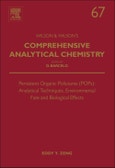This book focuses on those organic chemicals that are regulated by the Stockholm Convention on Persistent Organic Pollutants (POPs). as well as organic chemical with the attributes of being persistent, bioaccumulative, and toxic to ecosystem and human beings, criteria used by the Stockholm Convention for screening POP candidates. Because of the unfavourable properties of POPs, numerous research efforts have been directed toward investigating their input sources, fate, and effects, with the help of continuously improving analytical technologies. The contributors to this book provide an integrated assessment of existing data, which will benefit both the scientific and management communities in planning further research projects and/or pollution control measures.
Please Note: This is an On Demand product, delivery may take up to 11 working days after payment has been received.
Table of Contents
1. Analytical methods for the measurement of legacy and emerging POPs in complex sample matrices Ying Guo and Kurunthachalam Kannan 2. Bioanalytical approaches to understanding toxicological implications of mixtures of persistent organic pollutants in marine wildlife Ling Jin, Caroline Gaus, and Beate I. Escher 3. Fast analytical techniques based on microextraction Ruifen Jiang and Gangfeng Ouyang 4. Application of passive sampling techniques in measurement of HOCs in aquatic environments Lian-Jun Bao and Eddy Y. Zeng 5. Assessment of sediment toxicity with SPME-based approaches Jing You, Huizhen Li, and Michael J. Lydy 6. Pharmaceuticals and personal care products (PPCPs) in the environment and their removal from wastewater through constructed wetlands Cristina Ávila and Joan García 7. Occurrence and fate of PPCPs in wastewater Trine Eggen and Christian Vogelsang 8. Atmospheric deposition of POPs: Implications for the chemical pollution of aquatic environments Javier Castro Jiménez, Jordi Dachs and Steven J. Eisenreich 9. Electronic waste: a new source of halogenated organic contaminants Hong-Gang Ni and Eddy Y. Zeng 10. Occurrence and human health risk of emerging organic contaminants in E-waste David O. Carpenter 11. Long-range and regional atmospheric transport of POPs and implications for global cycling Kimberly J. Hageman, Christian Bogdal, and Martin Scheringer 12. Occurrence and ecological risk of halogenated flame retardants (HFRs) in coastal zones James C.W. Lam and Paul K.S. Lam 13. Atmospheric long-range transport of persistent organic pollutants (POPs) into Polar Regions Roland Kallenborn, Hayley Hung, and Eva Brorstrøm-Lundén 14. Bioaccumulation and biotransformation of brominated flame retardants Liesbeth Weijs, Alin C. Dirtu, Govindan Malarvannan, and Adrian Covaci 15. Bioavailability of persistent organic pollutants in soils: concept, analytical tools and application in the risk assessment, Bilqees M. Adedigba and Kirk, T. Semple 16. Benzotriazoles: history, environmental distribution and potential ecological effects Mark G. Cantwell, Julia C. Sullivan, and Robert M. Burgess 17. QSARs on the thyroid hormone effects of polybrominated diphenyl ether (PBDE) derivatives Fei Li, Xianhai Yang, Jingwen Chen, and Felichesmi Lyakurwa 18. The toxicity of persistent organic pollutants to aquatic organisms S. Michele Harmon 19. Health-based risk assessment of PBDEs, Li Chen, Lucy Li, and Yunhui Zhang








